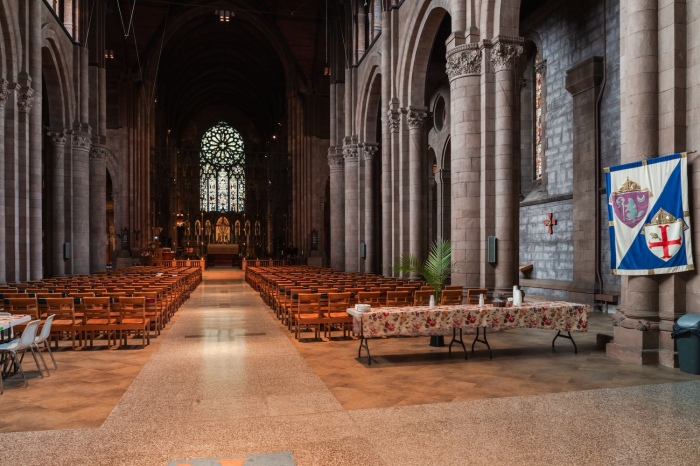A Glimpse into the Gothic Revival of Albany’s Cathedral of All Saints
Tucked away on a quiet side street near New York’s state Capitol, the Cathedral of All Saints in Albany is a striking example of Gothic revival architecture that often leaves visitors in awe. Its sandstone walls and intricate details evoke a sense of timelessness, making it seem as though it belongs in the heart of England rather than upstate New York. Every element of the cathedral, from its flying buttresses and pointed-arch windows adorned with stained glass to the elaborately carved baptismal font, reflects a deep commitment to medieval design.
As the seat of the Episcopal bishop of Albany, this cathedral was the first purpose-built structure for American Anglicans. The cornerstone was laid in 1884, with Governor Grover Cleveland—later to become the 23rd president of the United States—present at the event. The construction of the cathedral was not just an architectural endeavor but a reflection of the era’s values and craftsmanship. Traditional building techniques were used, ensuring that elements like arches, vaults, and flying buttresses served both aesthetic and structural purposes.
The finishing touches on the cathedral were made possible by the generosity of wealthy patrons from the Gilded Age, including financier J.P. Morgan. His contributions helped fund the quire and high altar, adding to the cathedral’s grandeur. Today, worshipers can feel transported back in time, standing just blocks away from the modern political landscape of New York while surrounded by the echoes of centuries past.
The design of the cathedral is inspired by some of the most iconic English cathedrals, such as those in Canterbury, Lincoln, and St. Albans. It was influenced by the work of Augustus W.N. Pugin, a leading figure in the Gothic revival movement of the 19th century. However, the cathedral remains incomplete, with only about 40% of the original plans realized. Twin towers never rose at the west front, and the central crossing, intended to reach toward the heavens, was never completed.
This incompleteness is most noticeable at the west front, which serves as the main entrance. The simple facade, built in the early 1970s, appears temporary and lacks the grandeur of the rest of the structure. Modern glass doors further detract from the overall aesthetic, failing to match the cathedral’s historical character.
Despite these challenges, the cathedral continues to function as a place of worship. The Very Rev. Leander Harding, the dean, remains optimistic about completing the project, even as the realities of financial constraints loom large. The Episcopal Church, like many Mainline Protestant denominations, has faced decades of decline, and the costs associated with finishing the cathedral are prohibitive. This situation mirrors that of other unfinished cathedrals, such as the Cathedral of St. John the Divine in New York City.
Even in its current state, the Cathedral of All Saints remains an extraordinary space. It is not merely a museum but a living house of worship where visitors can experience its beauty and history firsthand. For those interested in visiting, attending a service is the best way to fully appreciate the cathedral. Services are held at various times throughout the week, offering opportunities for reflection and connection.
When planning a visit, it’s advisable to arrive a bit early to take in the full experience. Sitting midway down the nave provides the best view of the choir and altar. Afterward, take time to explore the space quietly, noticing the details that make the cathedral unique. Don’t forget to circle the building and admire the impressive buttresses up close.
Whether you’re a visitor or a regular attendee, the Cathedral of All Saints offers a rare glimpse into the past and a testament to the enduring power of faith and architecture.



